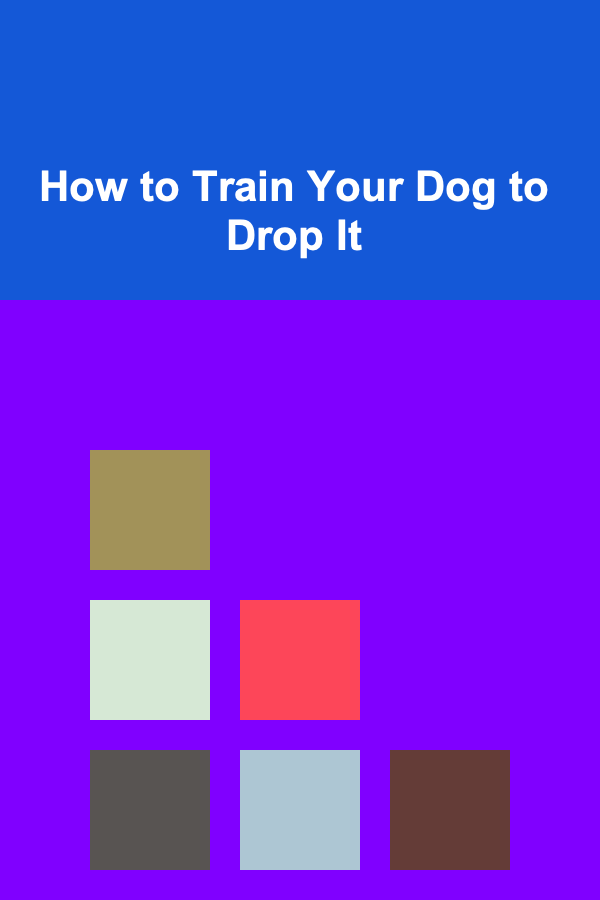
How to Train Your Dog to Drop It
ebook include PDF & Audio bundle (Micro Guide)
$12.99$6.99
Limited Time Offer! Order within the next:

Training your dog to "drop it" is one of the essential commands that every dog owner should teach their furry companion. Whether you're trying to keep your dog from chewing on something harmful, retrieving an item, or simply getting them to release something they shouldn't have, teaching the "drop it" command can help in various situations. This command is crucial for both your dog's safety and the well-being of those around them.
In this guide, we will cover the importance of the "drop it" command, step-by-step training methods, common challenges you may encounter, and how to troubleshoot any issues that arise. By the end of this article, you will have a clear understanding of how to train your dog to drop it reliably and efficiently.
Understanding the Importance of "Drop It"
Before diving into the training process, it's important to understand why teaching your dog to "drop it" is so crucial. Here are a few reasons why:
1. Safety Concerns
Dogs, especially puppies, have a tendency to grab anything they find. This can include dangerous items like toxic substances, small objects that could be a choking hazard, or sharp items. Teaching your dog to drop these things immediately can prevent accidents and ensure their safety.
2. Preventing Destructive Behavior
Dogs often chew on inappropriate objects like shoes, furniture, or even household items. If they pick up something they shouldn't, it's vital to have a reliable way to get them to release it before the item is damaged. The "drop it" command helps to control and prevent these destructive behaviors.
3. Building Trust and Control
Training your dog to drop it enhances the bond between you and your dog. It builds trust as your dog learns to listen to your commands. It also gives you control over situations where your dog may be holding onto something they shouldn't, allowing you to guide their behavior in a positive way.
4. Rescue and Retrieval
The "drop it" command is also important when playing fetch or retrieving objects. A reliable drop it command ensures that your dog will return the item to you without hesitation, making your playtime more enjoyable and efficient.
Step-by-Step Guide to Training "Drop It"
Training your dog to drop it involves using positive reinforcement and consistency. Below is a detailed step-by-step guide to help you achieve this goal.
Step 1: Prepare for Training
Before you start training, ensure that you have the following:
- A high-value treat: Use something your dog finds irresistible, such as pieces of chicken, cheese, or a special treat they don't get every day. This will help keep them motivated.
- A toy or object: This could be your dog's favorite toy, a ball, or any item they like to hold onto. It should be something they're eager to grab and hold.
- A quiet training environment: Choose a space with minimal distractions to help your dog focus on the task at hand.
Step 2: Get Your Dog Interested in the Object
Start by engaging your dog with a toy or an object they love. Let them grab the object and start playing with it, but don't ask them to drop it just yet. Allow them to enjoy the item for a few moments to get them fully engaged. This step is crucial because your dog needs to understand that you are using an object they want.
Step 3: Introduce the Command
Once your dog has a firm grip on the object, offer them the high-value treat in exchange. Hold the treat close to their nose, but don't give it to them right away. As they sniff the treat, they'll likely let go of the object in order to get the reward.
At the moment your dog releases the item, immediately say "drop it" in a clear, calm voice. When they let go, reward them with the treat. This step links the action of dropping the item with the reward.
Step 4: Repeat the Process
Repeat this process several times. The key is consistency. Each time your dog lets go of the item, reinforce it with praise and a treat. This will help your dog associate the action of dropping something with a positive experience.
Step 5: Add the Command
After a few successful repetitions, begin to use the command "drop it" right before your dog releases the object. Over time, your dog will start to associate the phrase "drop it" with the action of releasing the item.
Step 6: Practice Without a Treat in Hand
Once your dog starts reliably releasing the object on command, you can start practicing without holding the treat in your hand. Instead, have the treat in your pocket or on a table, and continue using the "drop it" command. Praise and reward them once they release the object and earn their treat.
Step 7: Increase Difficulty
Now that your dog is consistently responding to the "drop it" command, increase the difficulty level. You can do this by:
- Using more challenging objects: Start using objects that are more difficult to part with, such as chewier toys or items they find particularly fun.
- Adding distractions: Practice in different environments with more distractions, such as outside or during a walk.
- Increasing the duration: Ask your dog to hold onto the object for longer periods before you give the "drop it" command.
By gradually increasing the difficulty, your dog will learn to drop it in any situation, regardless of the object or the distractions around them.
Troubleshooting Common Challenges
While the "drop it" command is straightforward, some challenges may arise during the training process. Here are some common issues and how to address them:
1. Your Dog Won't Release the Object
If your dog refuses to drop the item, it may be because they find it particularly valuable or fun to chew on. To address this:
- Use a higher-value treat: Try using an even more appealing treat to motivate your dog to release the object.
- Be patient: Some dogs may take longer to catch on to the command. Keep practicing, and be patient with them.
2. Your Dog Drops the Item Too Quickly
If your dog is releasing the object as soon as you offer the treat, they may not be understanding the full "drop it" command. This could be due to a lack of association between the verbal cue and the action.
To solve this:
- Slow down the process: Don't rush to give the treat immediately. Wait for your dog to release the object only after you say the "drop it" command and give them time to respond.
- Reinforce the "drop it" command: Say the command in a clear, calm voice and reward them only after they drop the object voluntarily.
3. Distractions During Training
If your dog gets distracted and refuses to focus on the training, practice in a quieter environment without any distractions. As your dog becomes more consistent, gradually introduce distractions to help them learn to stay focused.
Tips for Success
Here are a few additional tips to help ensure your training is successful:
- Stay calm and patient: Dogs can sense frustration, so stay calm and patient during the training process.
- Be consistent: Use the same words, gestures, and methods each time you train.
- Short training sessions: Keep training sessions short (around 5 to 10 minutes) to avoid overwhelming your dog.
- End on a positive note: Always end training sessions with a successful attempt so that your dog associates the experience with a positive outcome.
Conclusion
Training your dog to "drop it" is a vital skill that can improve your dog's safety, prevent destructive behavior, and foster a stronger bond between you and your pet. With patience, consistency, and positive reinforcement, your dog will quickly learn this important command.
Remember that the key to success lies in gradual training, rewarding the correct behavior, and adjusting your approach to meet your dog's individual needs. By following the steps outlined in this article, you will be well on your way to teaching your dog to "drop it" reliably and efficiently.

How to Create a Study Playlist for Improved Concentration
Read More
How to Improve Your Credit Score and Maintain It
Read More
How to Make Your Own Artisan Bread at Home
Read More
How To Craft a Satisfying Resolution
Read More
Exploring the Truth Behind the Georgia Guidestones
Read More
10 Tips for Polishing Antique Gemstones: Preservation and Restoration
Read MoreOther Products

How to Create a Study Playlist for Improved Concentration
Read More
How to Improve Your Credit Score and Maintain It
Read More
How to Make Your Own Artisan Bread at Home
Read More
How To Craft a Satisfying Resolution
Read More
Exploring the Truth Behind the Georgia Guidestones
Read More